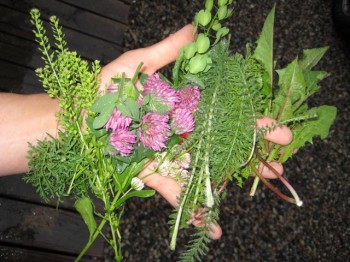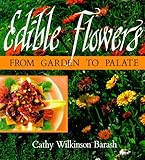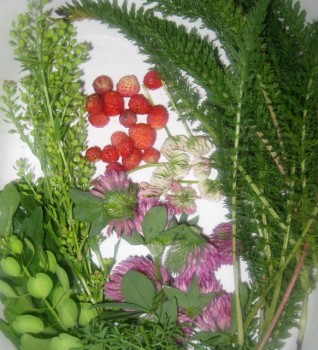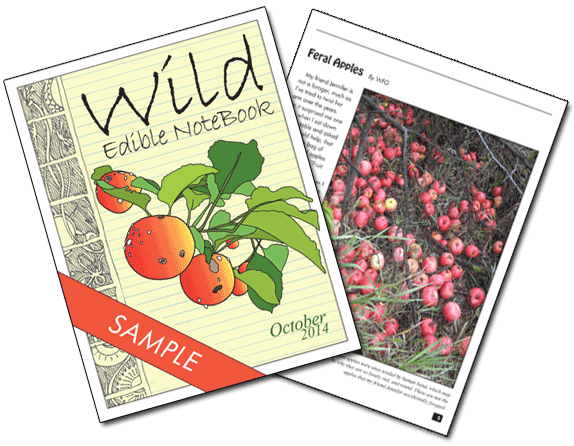
It’s a treat to be home to the quiet of the mountains again. I awoke today to the sweet, silent obscurity of the early morning dark followed by a sunrise of pale yellow behind bulbous, deep purple clouds left over from last night’s rainstorm. It must have rained hard while we were gone because the rains near washed out the driveway again. In exchange, however, they left us a cornucopia of lush wild edibles among all the other beautiful weeds, a warm welcome back to the house and to writing about wild edible plants after my long hiatus.
Our wild discoveries started yesterday evening with tiny wild strawberries—not hanging from the strawberry plants in our yard (which in two years have yet to fruit), but from plants on the dirt roadside lining a short stroll around the neighborhood that we enjoyed in the dimming light in a misty rain under the shelter of Gregg’s Pop-pop’s red two-person umbrella. We picked 18 strawberries the size of my pinky nail (and I bite my nails) while ruminating on the decimation of the bird feeders during our absence by what we can only imagine is an errant bear in the neighborhood. “Walk quietly; Henry (the bear) is probably out eating strawberries, too,” Gregg said, painting a picture I’d like to believe in place of the rummaging for ill-attended garbage that in reality he’s probably doing.
In addition to strawberries, the easement yielded a handful of furry, pale green yarrow leaves that I will dry and save for a wild tea mix I’m planning, to contain also mullein, fireweed leaves, and red clover flowers. In the misty half-light, too, I discovered that dandelions have moved into our neighborhood—a fact which naturalists would likely eschew (along with this whole neighborhood of new construction on former forest lands, for that matter), but which I find convenient now that the damage is done and humans and nature will have to co-exist here. I can’t say I’ll mind doing my part controlling the non-native species like dandelions and pennycress by foraging them aggressively for consumption. Anyway, I gathered a few seemingly-young dandelion bunches from the road easement, despite the fact that they were covered in a thin layer of gritty mud. They will be the first dandelions to hit our plates that we foraged within walking distance of the house.
 The yard sprang up nicely, albeit unexpectedly, in our absence. In the spot where I sowed cups of hand-harvested wild pennycress seed earlier this year, we instead have an amazing, lush garden of red clover without even a single pennycress plant. The timing is fine by me, since I recently purchased Edible Flowers from Garden to Palate (1993) by Cathy Wilkinson Barash, and my mind is presently spinning about clover preparation ideas gleaned from her book including clover tea, pickled clover, clover honey, and candied clover. Smaller, white-blossomed clovers are growing amidst the purple-flowered red ones, so I gathered a few of those as well to add to the recipes, per Barash’s recommendation.
The yard sprang up nicely, albeit unexpectedly, in our absence. In the spot where I sowed cups of hand-harvested wild pennycress seed earlier this year, we instead have an amazing, lush garden of red clover without even a single pennycress plant. The timing is fine by me, since I recently purchased Edible Flowers from Garden to Palate (1993) by Cathy Wilkinson Barash, and my mind is presently spinning about clover preparation ideas gleaned from her book including clover tea, pickled clover, clover honey, and candied clover. Smaller, white-blossomed clovers are growing amidst the purple-flowered red ones, so I gathered a few of those as well to add to the recipes, per Barash’s recommendation.

As for the pennycress—not to worry, it is far from absent this year. If I recall correctly, pennycress seeds are viable for decades, so the front-yard pennycress is bound to spring up some time or another. In the meantime, this year’s pennycress crop has overtaken one of the beds in the back yard. In the spirit of yesterday’s wild cornucopia, I gathered some of the pennycress’ young, peppery leaves and green penny-shaped seedpods. Peppergrass (Lepidium) is all over the place right now too, so that was the final plant I foraged for yesterday’s bounty. The pennycress and peppergrass will most likely find their way into fried eggs or a stir fry later today.
I have yet to decide what to do with the tiny wild strawberries that inspired yesterday’s fruitful harvest. I considered using them to make one delicious muffin, although it seems like an extravagant amount of work for one small baked good. What do you think?

Leave a Reply